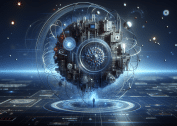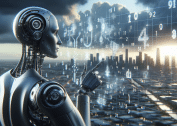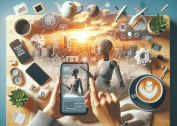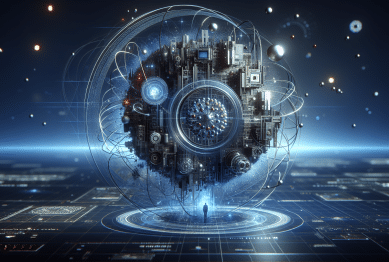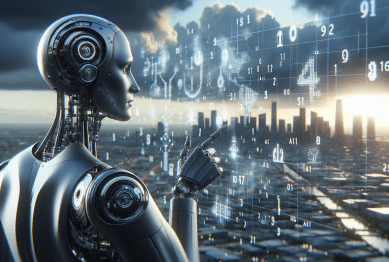Curious about artificial intelligence in your daily routine? This guide explores practical AI tools that can streamline tasks, spark creativity, boost productivity, and help you solve real problems. Find out how machine learning, automation, and smart assistants are changing the way you work and live.
Understanding Everyday AI and Its Impact
Artificial intelligence is no longer limited to futuristic labs or science fiction. It’s now quietly integrated into many common tools and applications people use every day. From your smartphone camera that suggests the perfect shot, to voice assistants like Siri and Alexa responding to simple requests, AI-driven experiences have become mainstream. The concept of AI tools refers to software and systems that mimic human abilities such as learning, reasoning, and adapting. These solutions can automate tedious processes, find patterns in data, and even suggest creative ideas in different industries.
So, how does this technology influence your personal and professional life? Many AI-powered tools provide task automation, making time-consuming activities quicker and more efficient. Email management systems sort important from unimportant messages, while smart scheduling apps recommend the optimal time for team meetings. These AI innovations make it easier for individuals and businesses to focus on higher-level thinking instead of repetitive work. Even entertainment platforms like Netflix and Spotify leverage machine learning for personalized recommendations, delivering content tailored to your tastes and moods.
The potential for AI stretches beyond convenience; it sparks innovation in areas like healthcare, education, and sustainability. Researchers use neural networks to identify patterns in medical imaging, helping doctors reach accurate diagnoses faster. In classrooms, adaptive e-learning systems adjust content according to a student’s pace and understanding. As AI tools continue to evolve, their impact on productivity, creativity, and problem-solving grows more profound, making them essential assets for those seeking a competitive edge (Source: https://www.nationalacademies.org/our-work/technological-breakthroughs-for-scientific-progress).
Smart Assistants and Voice Automation in Daily Tasks
Smart assistants have transformed the way people interact with technology, often making digital experiences more conversational and hands-free. These AI helpers—such as Google Assistant, Siri, and Amazon Alexa—respond to spoken questions and commands. Whether it’s setting reminders, checking the weather, or playing music, they streamline daily routines. Smart assistants can connect with other devices to control lighting, thermostats, or security cameras with a voice prompt. This integration creates a more seamless and responsive living or working environment.
But their appeal goes beyond convenience. Many individuals take advantage of AI voice automation to enhance productivity. For instance, calendar scheduling with spoken instructions accelerates organizing meetings and deadlines. Custom routines allow users to bundle multiple actions—like turning off lights, adjusting the thermostat, and locking doors—into a single command. As speech recognition and natural language processing improve, smart assistants are poised to handle even more complex workflows, adapting their responses based on context and user preferences.
Security and privacy remain chief considerations in this space. Users should explore built-in privacy settings and remain vigilant about permissions. Voice data may be stored or analyzed to improve accuracy, so transparency from device manufacturers is essential. When used responsibly, these AI-powered assistants offer innovative solutions for effortless interaction and automation in everyday life, enabling users to manage time and information flow more effectively (Source: https://www.nist.gov/news-events/news/2021/03/advancing-voice-recognition-technology-better-ai).
Automated Productivity Tools and Machine Learning Applications
Automated productivity tools represent another core domain where AI tools shine. Platforms like Notion, Grammarly, and Zapier use machine learning and automation to accelerate office work. For example, advanced spelling and grammar checkers can now suggest stylistic improvements by understanding context—far beyond simple correction. Similarly, workflow automation tools help link apps and services together, so actions in one system trigger related results elsewhere without manual intervention. These AI-driven systems reduce manual data entry, minimize human error, and let users focus on more meaningful tasks.
Project managers leverage AI-powered scheduling assistants to track progress and allocate resources efficiently. These systems learn from usage patterns and suggest ways to optimize team performance. Meanwhile, email triage tools help filter incoming mail, flagging high-priority threads for fast response. In analytics, business intelligence solutions harness AI algorithms to uncover actionable insights from vast datasets—enabling leaders to make smarter, data-driven decisions. These integrations are changing industries and giving users valuable time back in their day.
Such productivity gains rest on core machine learning models that continuously improve as they receive more inputs. Their success depends on accuracy, transparency, and ethical usage. Exploring these tools can be eye-opening for anyone struggling with distractions or overwhelmed by information overload. As automated task management becomes more advanced, expect even more intuitive, AI-enhanced work environments to emerge (Source: https://datascience.nih.gov/artificial-intelligence).
Using AI for Personalized Learning and Creative Expression
Artificial intelligence isn’t only about productivity—it can inspire creativity and support learning journeys as well. AI-powered design platforms like Canva and Adobe Sensei simplify professional-grade graphic design or photo editing, even for beginners. These systems suggest color palettes or layouts based on your project goals. AI-driven writing assistants offer grammar correction, style improvement, and even creative prompts for brainstorming sessions. Personalized learning platforms adapt questions and lessons to individual progress, keeping motivation high while reinforcing strengths and addressing weaknesses.
Language-learning apps and music recommendation engines harness AI to tailor lessons or playlists to your tastes. Instead of generic practice sessions, these systems analyze your preferences and adjust their approach dynamically. In classrooms, AI tutors help reinforce complex concepts and provide instant feedback. Educators use innovative assessment techniques powered by machine intelligence to ensure no student is left behind. Creative professionals in music, art, or design harness algorithmic suggestions as sparring partners that spark new ideas, not replacements for original thought.
Even in fields like journalism and content creation, AI tools support drafting, summarizing, and fact-checking. The key is finding the right balance between machine suggestions and human instinct. Learners and creators benefit from tailored experiences that evolve as their needs change. These applications unlock more personalized learning and creative exploration than ever before (Source: https://digitalpromise.org/2020/09/29/how-educators-are-using-ai-to-support-personalized-learning/).
AI in Health, Wellness, and Accessibility Solutions
Health and wellness have seen dramatic advances thanks to AI tools. Wearable fitness trackers use algorithms to monitor steps, heart rate, and sleep cycles, producing actionable wellness guidance. Virtual health assistants offer symptom checks and appointment scheduling, which help both patients and professionals. In clinical settings, AI-powered diagnostic systems assist healthcare workers in spotting potential issues early, helping direct care where it’s needed, while robotics and automation speed up repetitive, behind-the-scenes tasks at hospitals.
AI also plays a vital role in accessibility. Speech-to-text convertors, real-time captioning, and automated sign language interpreters enhance digital inclusion for those with hearing or speech challenges. Computer vision helps guide visually impaired users and describe physical environments via smartphone cameras. On the mental health front, AI chatbots and counseling apps offer conversation, emotional support, or mood tracking—never as a replacement for professional care, but as a supplement or bridge to it. This opens the door to a more equitable and proactive approach to health and self-care.
However, adoption comes with challenges. User privacy and ethical use of health data are paramount. Successful AI medical innovations are always developed with robust safeguards and transparency. When managed responsibly, these tools produce tangible benefits in wellbeing, preventative care, and accessibility for millions (Source: https://www.hopkinsmedicine.org/news/articles/how-ai-is-transforming-health-care).
Choosing the Right AI Tools for Your Needs
As the range of available AI solutions grows, the challenge becomes choosing those that fit your requirements. Assess functionality—is the tool designed for time management, creative work, learning, or well-being? Reviews and user feedback can reveal practical strengths and limitations. Consider the platform’s integration with your existing devices and systems. Test AI features like voice recognition or recommendation accuracy, and monitor how they evolve through updates. Sticking with reputable providers can mitigate risks of data misuse and subpar performance.
Another aspect to weigh is how AI tools handle user privacy and security. Transparent privacy policies and customizable controls are essential, especially for solutions dealing with sensitive information. Investigate how the system stores, transmits, and deletes your data. Some providers have certifications or endorsements from standards organizations, which can be a positive indicator. For collaborative environments or families, shared access or parental controls might also be priorities. Start with small projects to see how AI fits into your workflow before committing widely.
Lastly, explore ongoing education as part of using AI. Many platforms offer tutorials, webinars, and support documentation to help users maximize value while remaining vigilant to ethical considerations. Staying aware of updates, responsible use, and data rights will help you realize the full advantages of artificial intelligence without surprises. When selected carefully and applied with intention, AI tools can become trusted partners in work, learning, and creativity (Source: https://www.consumerreports.org/electronics/artificial-intelligence/how-to-choose-the-right-ai-product-a3721229738/).
References
1. National Academies of Sciences, Engineering, and Medicine. (n.d.). Technological Breakthroughs for Scientific Progress. Retrieved from https://www.nationalacademies.org/our-work/technological-breakthroughs-for-scientific-progress
2. National Institute of Standards and Technology. (2021). Advancing Voice Recognition Technology: Better AI. Retrieved from https://www.nist.gov/news-events/news/2021/03/advancing-voice-recognition-technology-better-ai
3. National Institutes of Health. (n.d.). Artificial Intelligence. Retrieved from https://datascience.nih.gov/artificial-intelligence
4. Digital Promise. (2020). How Educators Are Using AI to Support Personalized Learning. Retrieved from https://digitalpromise.org/2020/09/29/how-educators-are-using-ai-to-support-personalized-learning/
5. Johns Hopkins Medicine. (n.d.). How AI Is Transforming Health Care. Retrieved from https://www.hopkinsmedicine.org/news/articles/how-ai-is-transforming-health-care
6. Consumer Reports. (n.d.). How to Choose the Right AI Product. Retrieved from https://www.consumerreports.org/electronics/artificial-intelligence/how-to-choose-the-right-ai-product-a3721229738/



